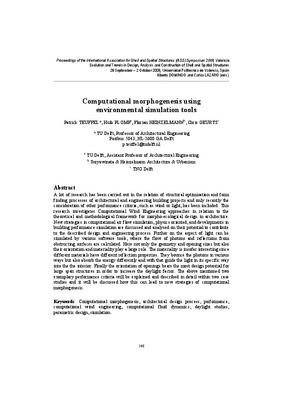JavaScript is disabled for your browser. Some features of this site may not work without it.
Buscar en RiuNet
Listar
Mi cuenta
Estadísticas
Ayuda RiuNet
Admin. UPV
Computational morphogenesis using environmental simulation tools
Mostrar el registro sencillo del ítem
Ficheros en el ítem
| dc.contributor.author | TEUFFEL, Patrick
|
|
| dc.contributor.author | PLOMP, Huib
|
|
| dc.contributor.author | HEINZELMANN, Florian
|
|
| dc.contributor.author | GEURTS, Chris
|
|
| dc.contributor.editor | Domingo Cabo, Alberto
|
es_ES |
| dc.contributor.editor | Lázaro Fernández, Carlos Manuel
|
es_ES |
| dc.date.accessioned | 2009-12-01T08:28:45Z | |
| dc.date.available | 2009-12-01T08:28:45Z | |
| dc.date.issued | 2009-12-01T08:28:45Z | |
| dc.identifier.isbn | 978-84-8363-461-5 | |
| dc.identifier.uri | http://hdl.handle.net/10251/6544 | |
| dc.description | p. 548-559 | en_EN |
| dc.description.abstract | A lot of research has been carried out in the relation of structural optimisation and form finding processes of architectural and engineering building projects and only recently the consideration of other performance criteria, such as wind or light, has been included. This research investigates Computational Wind Engineering approaches in relation to the theoretical and methodological framework for morpho-ecological design in architecture. New strategies in computational air flow simulation, physics oriented, and developments in building performance simulation are discussed and analysed on their potential to contribute to the described design and engineering process. Further on the aspect of light can be simulated by various software tools, where the flow of photons and reflections from obstructing surfaces are calculated. Here not only the geometry and opening sizes but also their orientation and materiality play a large role. The materiality is insofar interesting since different materials have different reflection properties. They bounce the photons in various ways but also absorb the energy differently and with that guide the light in its specific way into the the interior. Finally the orientation of openings bears the most design potential for large span structures in order to increase the daylight factor. The above mentioned two exemplary performance criteria will be explained and described in detail within two case studies and it will be discussed how this can lead to new strategies of computational morphogenesis. | en_EN |
| dc.language | Inglés | en_EN |
| dc.publisher | Editorial Universitat Politècnica de València | es_ES |
| dc.relation.ispartof | Symposium of the International Association for Shell and Spatial Structures (50th. 2009. Valencia). Evolution and Trends in Design, Analysis and Construction of Shell and Spatial Structures : Proceedings | en_EN |
| dc.rights | Reserva de todos los derechos | en_EN |
| dc.subject | Computational morphogenesis | en_EN |
| dc.subject | Architectural design process | en_EN |
| dc.subject | Performance | en_EN |
| dc.subject | Computational wind engineering | en_EN |
| dc.subject | Computational fluid dynamics | en_EN |
| dc.subject | Daylight studies | en_EN |
| dc.subject | Parametric design | en_EN |
| dc.subject | Simulation | en_EN |
| dc.title | Computational morphogenesis using environmental simulation tools | en_EN |
| dc.type | Comunicación en congreso | en_EN |
| dc.rights.accessRights | Abierto | es_ES |
| dc.description.bibliographicCitation | Teuffel, P.; Plomp, H.; Heinzelmann, F.; Geurts, C. (2009). Computational morphogenesis using environmental simulation tools. Editorial Universitat Politècnica de València. http://hdl.handle.net/10251/6544 | es_ES |
| dc.relation.conferencename | Symposium of the International Association for Shell and Spatial Structures | es_ES |
| dc.relation.conferencedate | 2009 | es_ES |
| dc.relation.conferenceplace | Valencia | es_ES |






